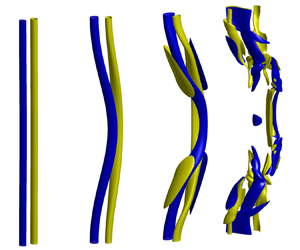Article contents
Is the Taylor–Proudman theorem exact in unbounded domains? Case study of the three-dimensional stability of a vortex pair in a rapidly rotating fluid
Published online by Cambridge University Press: 08 June 2021
Abstract

Owing to the Taylor–Proudman theorem, it is generally believed that rotating flows should have two-dimensional dynamics for rapid background rotation. Yet, we show that two infinitely long counter-rotating vertical vortices always remain unstable to three-dimensional perturbations even for large rotation rate about the vertical axis. The dominant instability consists of quasi-antisymmetric displacements of the two vortices. Its growth rate is independent of the rotation rate when it is sufficiently large, while the most amplified vertical wavelength scales like the rotation rate. Direct numerical simulations show that the instability leads ultimately to a full three-dimensional breakdown of the vortex pair. In other words, a two-dimensional vortex pair will spontaneously develop three-dimensional variations even in the limit of infinite rotation rate but the wavelength will tend to infinity. This implies that the Taylor–Proudman theorem can be strictly valid only in vertically bounded flows. The scaling for the wavelength is next generalized by showing that the typical vertical scale in rapidly rotating unbounded flows is  $L_v \sim L_h/Ro$, where
$L_v \sim L_h/Ro$, where  $L_h$ is the horizontal scale and
$L_h$ is the horizontal scale and  $Ro$ the Rossby number. This scaling law is shown to derive from a self-similarity of the Navier–Stokes equations for
$Ro$ the Rossby number. This scaling law is shown to derive from a self-similarity of the Navier–Stokes equations for  $Ro \ll 1$. The resulting reduced equations are identical to those obtained first by Julien et al. (Theor. Comput. Fluid Dyn., vol. 11, issue 3–4, 1998, pp. 251–261) and Nazarenko & Schekochihin (J. Fluid Mech., vol. 677, 2011, pp. 134–153) by means of multiscale analyses in the cases of rotating convection or turbulence. The self-similarity demonstrated herein suggests that these reduced equations are valid for any rapidly rotating unbounded flow.
$Ro \ll 1$. The resulting reduced equations are identical to those obtained first by Julien et al. (Theor. Comput. Fluid Dyn., vol. 11, issue 3–4, 1998, pp. 251–261) and Nazarenko & Schekochihin (J. Fluid Mech., vol. 677, 2011, pp. 134–153) by means of multiscale analyses in the cases of rotating convection or turbulence. The self-similarity demonstrated herein suggests that these reduced equations are valid for any rapidly rotating unbounded flow.
JFM classification
- Type
- JFM Rapids
- Information
- Copyright
- © The Author(s), 2021. Published by Cambridge University Press
References
REFERENCES
Billant supplementary movie 1
Movie 1 (a) Three-dimensional contours of the vertical vorticity in a Direct Numerical Simulation for Ro=0.76, b=3 and Re=500. Yellow and blue contours represent respectively plus and minus 50% of the vertical average of the maximum vertical vorticity in each horizontal plane. Three horizontal cross-sections of the vertical vorticity in the planes z=L_z/2 (b), z=3L_z/4 (c) and z=L_z (d) are also displayed. The location of these cross-sections are indicated by dashed lines with different color in (a). Note that only a portion of the computational domain is shown.
Billant supplementary movie 2
Movie 2 (a) Three-dimensional contours of the vertical vorticity in a Direct Numerical Simulation for Ro=1.53, b=3 and Re=500. Yellow and blue contours represent respectively plus and minus 50% of the vertical average of the maximum vertical vorticity in each horizontal plane. Three horizontal cross-sections of the vertical vorticity in the planes z=L_z/2 (b), z=3L_z/4 (c) and z=L_z (d) are also displayed. The location of these cross-sections are indicated by dashed lines with different color in (a). Note that only a portion of the computational domain is shown.
- 2
- Cited by





